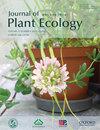生境条件对高山魔芋(Arum alpinum Schott)丰度和选择个体性状的影响西喀尔巴阡山脉populletum albae和Tilio cordata - carpinetum betuli群落中的Kotschy
IF 3.9
2区 环境科学与生态学
Q2 ECOLOGY
引用次数: 0
摘要
[摘要]高原Arum alpinum Schott &Kotschy于2020-2021年在西喀尔巴阡山脉的山麓进行。调查在Golesz自然保护区(第1块)、Markowce村附近(第2块)、Kozigarb自然保护区(第3块)和Żółków村附近(第4块)进行。第1和第3块建立在tilo cordataa - carpinetum betuli橡树-角梁林中,林下以窄叶低生长植被为主;而斑块II和斑块IV则建立在以阔叶植物为主的白杨河岸林中。高原魔芋种群数量以斑块I最多,但在斑块II和斑块IV中也存在大量的营养和生殖个体。个体性状的时间变异发生率从斑块IV的最低水平,经过斑块I和II,再到斑块III的最高水平。在所有种群中,叶柄长度与叶片尺寸、生殖茎长度与果序性状之间的显著正相关证实了先前的研究结果。研究表明,高山魔芋与特定的森林群落关系并不密切。显著的遮荫和湿润的富营养土壤适合本物种,而干燥的土壤和过度的日照可能会限制个体的开花和结果。本文章由计算机程序翻译,如有差异,请以英文原文为准。
The influence of habitat conditions on abundance and selected individual traits of Arum alpinum Schott & Kotschy in the communities Populetum albae and Tilio cordatae-Carpinetum betuli (Western Carpathians)
Abstract Studies of selected habitat conditions, as well as spatio-temporal variability of the number and selected traits of individuals of the species Arum alpinum Schott & Kotschy were carried out in 2020-2021 in the foothills of the Western Carpathians. The investigations were conducted in permanent patches located in the Golesz nature reserve (Patch I), near the village of Markowce (Patch II), in the Kozigarb nature reserve (Patch III), and near the village of Żółków (Patch IV). Patch I and Patch III were established in a Tilio cordatae-Carpinetum betuli oak-hornbeam forest with undergrowth dominated by low-growth vegetation with narrow leaves, whereas Patch II and Patch IV were established in a Populetum albae riparian forest with undergrowth dominated by broad-leaved species. The most abundant population of Arum alpinum was noted in Patch I, but substantial numbers of both vegetative and reproductive individuals were also present in Patches II and IV. The occurrence of temporal variability of individual traits increased from its lowest level in Patch IV, through Patches I and II, to its highest level in Patch III. The significant positive correlation noted in all populations between length of petioles and blade dimensions, as well as between length of generative stems and infructescence traits confirmed previous findings. The conducted research showed that Arum alpinum is not closely affiliated with a specific forest community. Significant shading and moist nutrient-rich soils are suitable for this species, while dry soils and excessive insolation might limit the flowering and fruiting of individuals.
求助全文
通过发布文献求助,成功后即可免费获取论文全文。
去求助
来源期刊

Journal of Plant Ecology
生物-植物科学
CiteScore
4.60
自引率
18.50%
发文量
134
审稿时长
3 months
期刊介绍:
Journal of Plant Ecology (JPE) serves as an important medium for ecologists to present research findings and discuss challenging issues in the broad field of plants and their interactions with biotic and abiotic environment. The JPE will cover all aspects of plant ecology, including plant ecophysiology, population ecology, community ecology, ecosystem ecology and landscape ecology as well as conservation ecology, evolutionary ecology, and theoretical ecology.
 求助内容:
求助内容: 应助结果提醒方式:
应助结果提醒方式:


